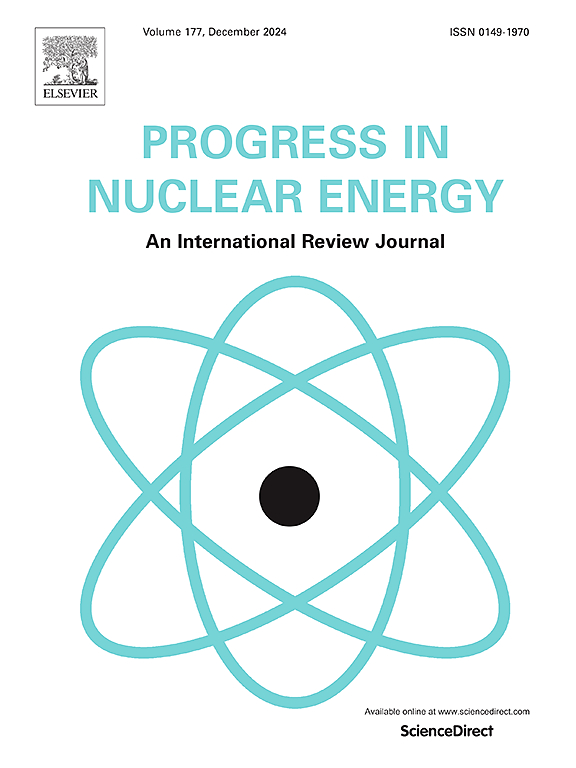一种用于抑制流体负载振荡和能量收集的控制阀
IF 3.3
3区 工程技术
Q1 NUCLEAR SCIENCE & TECHNOLOGY
引用次数: 0
摘要
控制阀在核电站设备中有着广泛的应用。在特定的工作条件下,阀内会发生流体振荡,导致阀芯上突然产生流体载荷,可能导致阀卡甚至阀杆断裂。为了解决这个问题,设计了一种创新的控制阀来抑制流体振荡,并收集流体振荡过程中通常耗散的能量。在阀体内安装了活塞组件,以减轻阀门的进口流体振荡,并利用部分振荡能量,否则将被消散,并系统地分析了影响该阀抑制流体振荡和捕获能量的因素。结果表明,该新型控制阀能够抑制流体振荡,并从控制阀内流体振荡过程中获取能量。所提出的方法在不影响控制阀调节能力的情况下,能明显消除或减少流体载荷对控制阀塞振荡的影响,减少阀内涡流的发生。这有助于解决当控制阀控制的流体不稳定、剧烈振荡时,阀门执行机构容易出现异常停机的问题。本文章由计算机程序翻译,如有差异,请以英文原文为准。
A control valve for fluid-load oscillation inhibiting and energy harvesting
Control valves are extensively utilized in the equipment of nuclear power plants. Under specific operational conditions, fluid oscillation occurs within the valve, resulting in sudden fluid loads on the valve core, which may lead to valve jamming and even stem breakage. To address this problem, an innovative control valve is designed to inhibit the fluid oscillation and harvest the energy typically dissipated during the fluid oscillation process. A piston component is situated within the valve body to mitigate inlet fluid oscillation of the valve and harness a portion of the oscillation energy that would otherwise be dissipated, and a systematic analysis of the factors affecting the valve's suppression of fluid oscillation and capturing energy in this valve is presented. The results show that the innovative control valve can inhibit fluid oscillation and harvest energy from the fluid oscillation process in the control valve. The proposed method does not affect the regulating ability of the control valve, and it can obviously eliminate or reduce the fluid load of the oscillation on the plug of the control valve, reduces the occurrence of vortices inside the valve. which helps to address the problem that the actuator of the valve is prone to abnormal shutdown when the fluid controlled by the control valve is unstable and violent oscillation.
求助全文
通过发布文献求助,成功后即可免费获取论文全文。
去求助
来源期刊

Progress in Nuclear Energy
工程技术-核科学技术
CiteScore
5.30
自引率
14.80%
发文量
331
审稿时长
3.5 months
期刊介绍:
Progress in Nuclear Energy is an international review journal covering all aspects of nuclear science and engineering. In keeping with the maturity of nuclear power, articles on safety, siting and environmental problems are encouraged, as are those associated with economics and fuel management. However, basic physics and engineering will remain an important aspect of the editorial policy. Articles published are either of a review nature or present new material in more depth. They are aimed at researchers and technically-oriented managers working in the nuclear energy field.
Please note the following:
1) PNE seeks high quality research papers which are medium to long in length. Short research papers should be submitted to the journal Annals in Nuclear Energy.
2) PNE reserves the right to reject papers which are based solely on routine application of computer codes used to produce reactor designs or explain existing reactor phenomena. Such papers, although worthy, are best left as laboratory reports whereas Progress in Nuclear Energy seeks papers of originality, which are archival in nature, in the fields of mathematical and experimental nuclear technology, including fission, fusion (blanket physics, radiation damage), safety, materials aspects, economics, etc.
3) Review papers, which may occasionally be invited, are particularly sought by the journal in these fields.
 求助内容:
求助内容: 应助结果提醒方式:
应助结果提醒方式:


